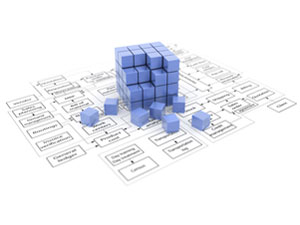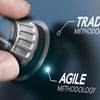SoftRoots Integration Services
 Data
Data
Data is one of the most valuable assets a business has, and for plenty of good reasons. Business data can define corporate value, support daily operations, provide a sound basis for
business decisions, as well as help identify future business opportunities to name a few. Having data readily available for business applications can also help streamline business
operations. Data integration is a key factor when it comes to designing solutions to support enterprise data, data automation, analytics, data migration, real-time data delivery,
and other comprehensive dynamic data-driven solutions. One or more of these factors often come to the fore to support business processes and operations, while maintaing data security
in order to remain competitive in today's fast-changing world.
Whether the development initiative is large or small, the task of integrating data can be challenging. Various processes are commonly involved to effectively generate, retrieve, validate,
display, update, protect, store, or export data in the format(s) required. Many of the "pitfalls" associated with combining data from disparate sources into meaningful and valuable
information can be avoided if knowledge and expertise is utilized to develop data integration solutions.
 Components
Components
Components are key building blocks of successful software solutions. In software engineering, components
come in many types, sizes, complexities, and capabilities. Depending of the component technology utilized, components can be reused, and/or integrated into other solutions that require
similar component capabilities. Smaller, more-simpler components are often good candidates for reuse, which can lead to improved robustness while reducing development costs. For larger,
more-complex components, technology bridges may be available to support reusability even if dissimilar technologies are present. Open source components often fall in this realm, which
can provide a jump-start to support larger development initiatives.
Advancements in component-based development across all platforms and programming languages has contributed significantly in support of integration initiatives. The role of object-oriented
programming and its use in component models, such as Java Beans and distributed object technologies has been instrumental. Many programming languages have matured into distributed component
models, and are now used to build distributed architectures; while others have become very modular by design, which may enable decoupling the application into blocks of functionality,
thereby making it easier to maintain and test. Both of these approaches has further contributed to component-based development.
 Frameworks
Frameworks
With literally hundreds of available frameworks to support development projects, powerful feature-rich applications are common today. However, understanding the pros and cons of the
various frameworks can eliminate many of the pitfalls that consume valuable development time and resources. Expertise and insight gained from working with many framework technologies, as well as related integration and framework extensions, can result in sound recommendations regarding
the frameworks best-suited to support a client's business requirements and needs.
An important factor when it comes to the integration of different frameworks is the need to identify early in the development effort if compatibilities issues exists between the different
frameworks considered for the related development initiative. Compatibility issues are more common when utilizing multiple frameworks, technologies, and/or platforms within a single project.
The earlier in a development cycle incompatibilities are identified, costly development may be avoided.
 Technologies
Technologies
With the rapid change of technologies today, it's imperative for businesses to have an integration strategy to enable a smooth transition from one technology to another. Also, being able
to effectively support multiple technologies within a given infrastructure can enable a wider-array of applications and solutions to support business operations. Technology integration is
often needed to build an integrated environment in which databases can seamlessly interact with applications.
When it comes to integrating different technologies, a deeper understanding may be required of the supported life-cycles, process workflows, and the supported frameworks they are built upon.
This is not only true for Enterprise Application Integration (EAI), but with the complexity of software today, the need to interface disparate technologies may exist, which may need to
support a single application solution. Additionally, with the need to support legacy system(s) or application(s) within an existing environment, technology bridges may also be needed to
facilitate communications between multiple disparate technologies.
Integration Services
Adaptable
Adaptable integration solutions to support new, as well as existing applications and systems within your infrastructure.
Seamless
Seamless integration solutions can more-fully support technology requirements, business automation, and operations.
Secure
Secure integration capability is crucial to support business operations in today's open systems environment.
Robust
Robust integration interfaces can support a variety of exception conditions ensuring continuous operations.
Serviceable
Serviceable integration solutions enable maintainable website and portal data communications with backend business systems.
Extendable
Extendable integration solutions can more-fully support future integration needs and/or business requirements.








